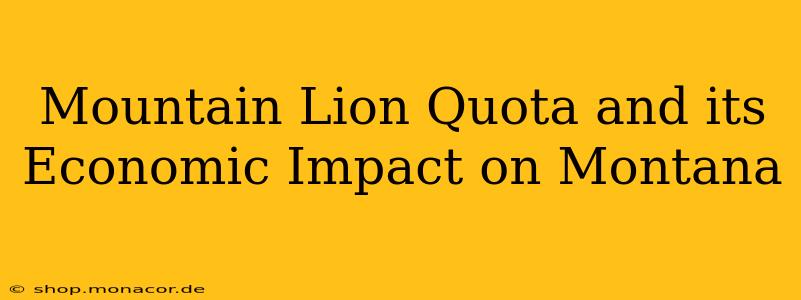Montana's mountain lion population and the management of this apex predator through quota systems are subjects of ongoing debate, significantly impacting both the ecological balance and the state's economy. This complex issue intertwines wildlife conservation, hunting practices, and the economic interests of various stakeholders. Understanding the nuances of mountain lion quotas and their economic consequences is crucial for informed decision-making.
What is Montana's Mountain Lion Quota System?
Montana's Fish, Wildlife & Parks (FWP) agency manages mountain lion populations through a system of hunting permits and quotas. These quotas vary by hunting district and are based on factors such as population estimates, habitat conditions, and public input. The goal is to maintain a healthy and sustainable mountain lion population while also addressing concerns from ranchers and livestock owners about predation. The system allows for both controlled hunting and regulated harvest, aiming for a balance between conservation and management. The specific quotas fluctuate yearly, reflecting adjustments based on data gathered through ongoing monitoring. This means there isn't a single, static number, but rather an annually adjusted figure determined by wildlife biologists and managers.
How Does the Mountain Lion Quota Impact the Economy?
The economic impact of mountain lion quotas in Montana is multifaceted and often debated. Here's a breakdown:
Positive Economic Impacts:
- Hunting Licenses and Related Spending: Mountain lion hunting generates revenue through the sale of hunting licenses, tags, and permits. Hunters also contribute to the local economy through spending on lodging, food, equipment, and guide services. This influx of money benefits businesses in rural communities throughout the state.
- Tourism and Wildlife Viewing: While not directly tied to hunting, the presence of mountain lions (and the management of their populations) can attract wildlife enthusiasts and tourists interested in observing these majestic animals. This contributes to the tourism sector and supports businesses catering to outdoor recreation.
- Meat and Hide Sales: Harvested mountain lions can provide meat and hides that have some commercial value, although this is a relatively small component of the overall economic impact.
Negative Economic Impacts:
- Livestock Losses: Mountain lions can prey on livestock, leading to economic losses for ranchers and farmers. While compensation programs exist, the cost of these programs and the overall impact on livestock production can be substantial. The debate often focuses on the effectiveness and fairness of these compensation programs.
- Potential Decrease in Hunting Tourism: A perception of over-hunting or mismanagement could deter some hunters and wildlife viewers, potentially leading to reduced tourism revenue. This is a concern voiced by those advocating for more cautious management strategies.
- Conflicts and Legal Costs: Disputes related to hunting regulations, compensation for livestock losses, or other issues associated with mountain lion management can lead to legal costs and administrative expenses for both the state and private landowners.
What are the Conservation Implications of Mountain Lion Quotas?
The conservation implications of mountain lion quotas are central to the ongoing discussion. The goal is to maintain a healthy population that doesn't threaten other species or livestock while ensuring the species' long-term survival. Finding the right balance is crucial. Over-hunting could lead to population decline, while insufficient management could result in increased conflict with human interests. This requires careful monitoring and adaptive management strategies.
Are there alternative methods for managing mountain lion populations?
Yes, several alternatives and supplemental approaches exist alongside quota systems:
- Non-lethal methods: These include habitat management to reduce conflicts between lions and livestock, and using deterrents to keep lions away from livestock.
- Predator-prey balance: Maintaining a healthy ecosystem that includes the natural prey of mountain lions is crucial for sustainable populations.
- Research and Monitoring: Continued scientific research and population monitoring is essential to make informed decisions about mountain lion management.
How are stakeholders involved in the decision-making process?
The Montana FWP engages various stakeholders in the decision-making process regarding mountain lion quotas. This includes:
- Hunters: Their perspectives are considered through surveys, public hearings, and comment periods.
- Ranchers and Livestock Owners: Their concerns about livestock losses are addressed through compensation programs and other mitigation strategies.
- Conservation Organizations: These groups advocate for conservation-minded management practices that prioritize long-term sustainability.
- Scientists and Researchers: They provide data and research findings to inform management decisions.
Conclusion:
The economic impact of Montana's mountain lion quota system is a complex issue with both positive and negative aspects. Balancing the economic benefits of hunting and tourism with the costs of livestock losses and the need for conservation requires careful consideration of all stakeholders and ongoing scientific monitoring. The future of mountain lion management in Montana will depend on the continued dialogue and collaboration among all involved parties.

